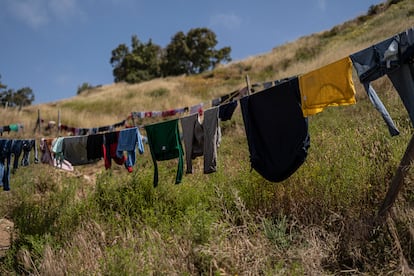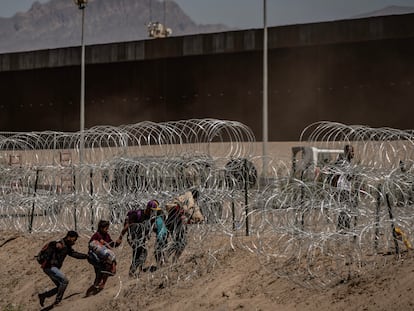Title 42 has expired on the US-Mexico border: Now what?
The end of Trump’s controversial immigration rule makes way for a new regime fraught with uncertainties. Here’s what’s known about what comes next

At 11:59 p.m. this Thursday, Washington time, Title 42 lost its effect on the lives of the thousands of migrants who arrive every day at the border separating Mexico from the United States. It was a rule imposed by the Donald Trump Administration under the pretext of halting the advance of the pandemic. It allowed the rapid expulsion of migrants, who were returned in a matter of minutes to Mexico. Its extinction opens a new era in migratory relations between the two countries, and it leaves open a number of questions that Joe Biden’s Administration hopes will be clarified as the weeks go by.
This regulation coexisted with Title 8, which stood alone for decades until March 2020. It was left to the discretion of immigration officials to decide whether to apply one rule or the other. In practice, they had been opting for weeks mostly for Title 8; Title 42 was only applied in 17% of the cases, a border patrol agent told EL PAÍS on Thursday in El Paso (Texas).
In the 2022 fiscal year, which runs from October to May, more than 1.15 million border detainees were subject to Title 8, compared to slightly more than 1.08 million for whom Title 42 was applied.
Title 8 involves a tightening of the conditions for seeking asylum. It allowed the Barack Obama Administration to deport more than three million migrants in eight years. The rule now incorporates new features: those who want to apply for asylum are obliged to request it through a mobile application from their countries of origin, so that they can travel with the certainty that they will be taken into consideration.

This requirement has been criticized by migrants, who consider the app difficult to use and requires them to have good internet access, something that’s not always the case and shouldn’t be taken for granted.
Regardless of the migrants’ complaints, if they arrive in the United States without having met this requirement or are ineligible for asylum, they will be deported. That deportation will entail a ban on trying again for at least five years. If they are caught trying to cross again within that time, they face prison sentences in the United States. Deportations will be to their countries of origin, except in cases where there are no agreements in place.
Those eligible for asylum in the United States will wait in a detention center while their application is resolved. They must demonstrate that they are in “credible fear,” that is, that their lives are in danger where they come from.
Those who pass that test are allowed to remain in the country while their cases go through the immigration courts. They receive a document with an appointment with a judge somewhere in the United States that allows them to travel freely throughout the country. The time frames vary, from several weeks to several years. Currently, there are two million open cases, and immigration judges are overwhelmed.
U.S. authorities expect the change to bring an increase in border crossings, which could reach 13,000 people a day, compared to 6,000 on a busy day just a few weeks ago. That will also have implications for the time immigration officials have to spend completing processing. Under Title 42, 10 minutes to 30 minutes was sufficient to decide removal. The process mandated by Title 8 rules increases that time to more than an hour.

This week, the United States also debuted a new asylum rule that will largely prohibit migrants who passed through another country before arriving at the border from seeking asylum in the United States. The rule, proposed earlier this year, understands that those individuals were able to seek refuge in those places but decided against it. Immigrants who secure an appointment through the CBP One application will be exempt.
The State Department also plans to open about 100 regional processing centers in the Western Hemisphere where immigrants can apply to be accepted in the United States, Canada or Spain. Little is yet known about how they intend to carry out these plans.
The combination of all these measures, a mix of providing more legal, though still limited, avenues and tightening border security to try to curb irregular crossings, is aimed at discouraging migrants from crossing the border illegally and preventing an unprecedented surge in asylum seekers. Experts have attested to a global trend that speaks of an unprecedented growth in migratory movements.
Sign up for our weekly newsletter to get more English-language news coverage from EL PAÍS USA Edition
Tu suscripción se está usando en otro dispositivo
¿Quieres añadir otro usuario a tu suscripción?
Si continúas leyendo en este dispositivo, no se podrá leer en el otro.
FlechaTu suscripción se está usando en otro dispositivo y solo puedes acceder a EL PAÍS desde un dispositivo a la vez.
Si quieres compartir tu cuenta, cambia tu suscripción a la modalidad Premium, así podrás añadir otro usuario. Cada uno accederá con su propia cuenta de email, lo que os permitirá personalizar vuestra experiencia en EL PAÍS.
¿Tienes una suscripción de empresa? Accede aquí para contratar más cuentas.
En el caso de no saber quién está usando tu cuenta, te recomendamos cambiar tu contraseña aquí.
Si decides continuar compartiendo tu cuenta, este mensaje se mostrará en tu dispositivo y en el de la otra persona que está usando tu cuenta de forma indefinida, afectando a tu experiencia de lectura. Puedes consultar aquí los términos y condiciones de la suscripción digital.
More information
Archived In
Últimas noticias
The complicated life of Francesca Albanese: A rising figure in Italy but barred from every bank by Trump’s sanctions
How Japan is trying to avert ‘digital defeat’
Half of Scotland is in the hands of 420 property owners
Reinhard Genzel, Nobel laureate in physics: ‘One-minute videos will never give you the truth’
Most viewed
- Pablo Escobar’s hippos: A serious environmental problem, 40 years on
- Reinhard Genzel, Nobel laureate in physics: ‘One-minute videos will never give you the truth’
- Why we lost the habit of sleeping in two segments and how that changed our sense of time
- Charles Dubouloz, mountaineering star, retires at 36 with a farewell tour inspired by Walter Bonatti
- The Florida Keys tourist paradise is besieged by immigration agents: ‘We’ve never seen anything like this’











































